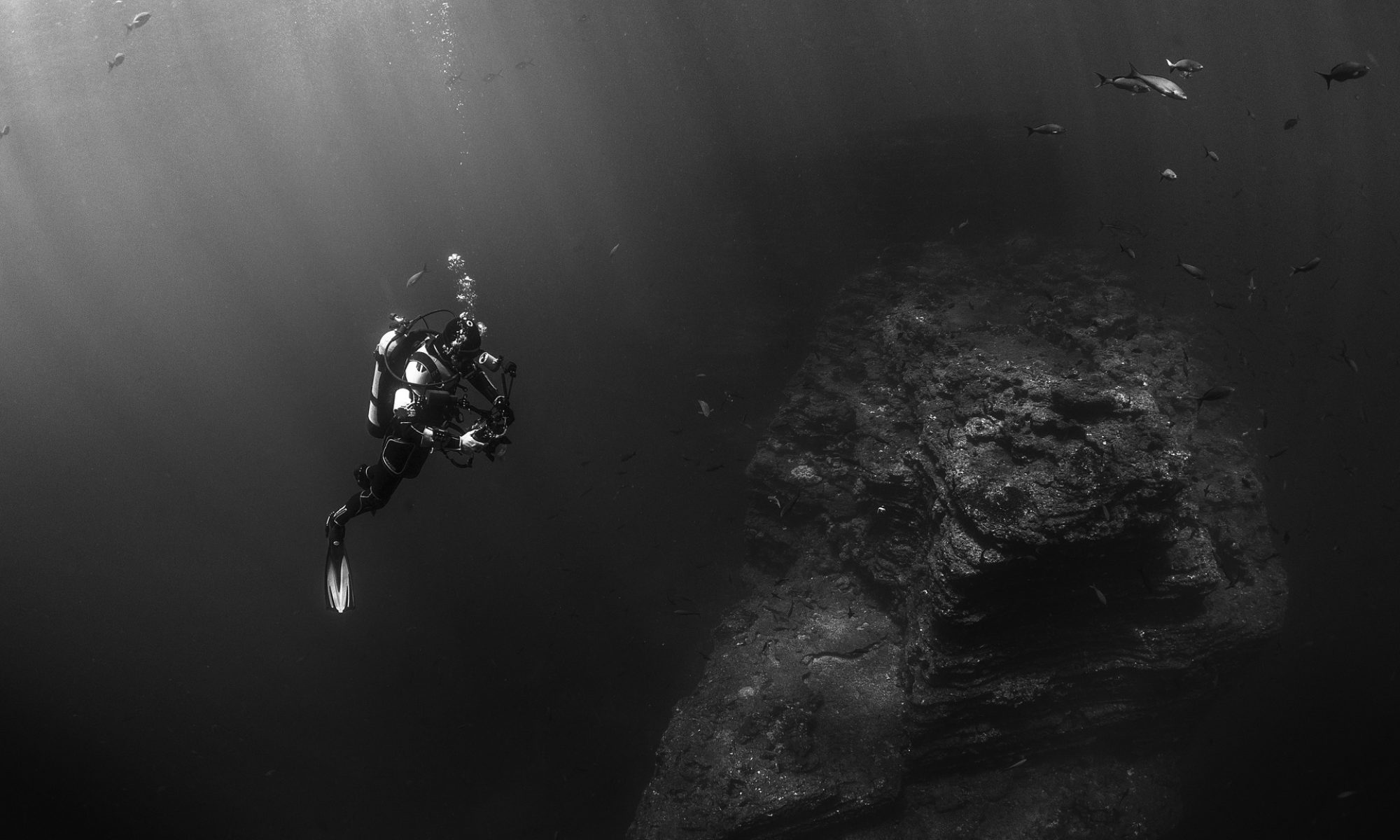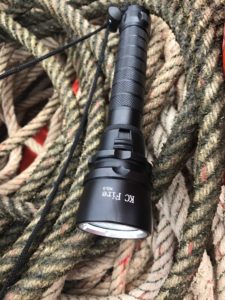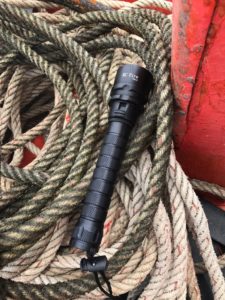Source: Amazon: Shenzhen Kechuang Fire Technology
Sample Price: £21.59 inc. shipping (Amazon Prime next day)
Box Contents: 1x Flashlight, 2x Batteries, 1x charger+cable, 1x Rope hand strap, 1x spare o-rings
Packaging: Cardboard box
Switch Type: Magnetic
Battery Type: 18650
Claimed Lumens: 3000
Measured Useable Lumen Estimate: 1068
Shipping time: next day (amazon prime)
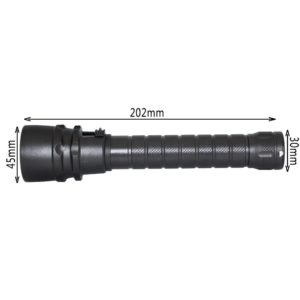
Review:
Review:
Today I’m reviewing a light from KC Fire in Shenzhen – based on three XM-L2 LED diodes, and the familiar 18650 batteries.
The format is similar to a traditional flashlight- cylindrical with no handles. The only signs that it’s more than your regular land-based flashlight is the switch (magnetic) and the two O-rings in the battery compartment. Turning it on while outside the water casts a very bright beam (not as bright as the XHP70 based light tested a while back by KC Fire, but still very bright)
At 1m distance it throws three primary, overlapping, cones of light with a diffused circle around the three (all measurements taken in a dark room with <2lux background light). This makes sense as it’s running three LEDs instead of one.kc
Inner cone: 30cm diameter (i.e. 17degree beam), average lux 6468 (5 readings) – peak 8270 (remember lux, NOT lumens)
Outer cone: 120cm diameter (i.e. 62degree beam), average lux 576 (8 readings) – peak 690 (remember lux, NOT lumens)
So…. After some simple math, the 30cm cone has around 457lumens, while the 120cm (dimmer) cone has 610 lumens at 1 meter. This adds up to a total useable lumen count of 1068 lumens.
1m behind the flashlight (pointed at a matt white wall), I get 70-ishlux readings, taken in a spherical area, 1m away from the light. Importance of this is that lumen output from a flashlight is meant to be measured in a sphere around the light, not just on the flat surface it’s projected against. So with a sphere of 1m radius (2m diameter, 6.28m surface area), and assuming the light pumps out an average of 75lux all around – we are looking at 855 lumens. So if we counted this, we would go up to 1923 lumens (total, theoretical).
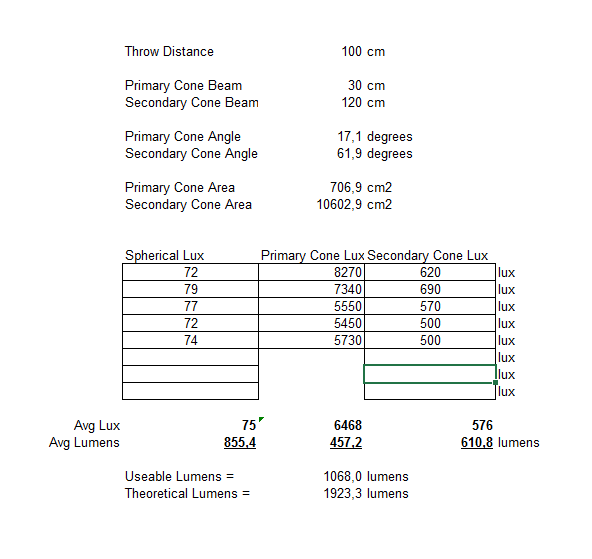
Given that I now have a battery tester (took a while to arrive), I decided to put the batteries through their paces as well. The batteries that come with the flashlight are unbraded, but have some text stating 3000mAh on them. The following numbers come from discharge testing (i.e. they are fully charged, then allowed to discharge under a constant load until the voltage is too low to support an LED).This averages out to 1960mAh for the batteries, which isn’t too bad for a 18650, but nowhere near the 3000mAh printed.
| 1834 mAh | 1955 mAh | 2001 mAh | 2004 mAh | 2002 mAh |
Build quality is similar to the other light from KC fire – feels very tough. The CNC’ed aluminium case and glass lens are rugged. The front lens is recessed, so should protect it from some scratches. Feels like glass, but can’t confirm.
I brought it with me to Thailand for two weeks – putting it through its paces both on land and in the water. When illuminating darker parts of the forests or temples, it was clearly brighter than any flashlight the guides we used had. When in the water, the brightness was about average compared to big-brand lights. It’s definitely bright – bright enough that you cannot look into the beam directly.
Duration has been pretty good, lasting around 2 hours before I can tell that the light is dimmer; meaning for my hour-long dives, I have ample burn time.
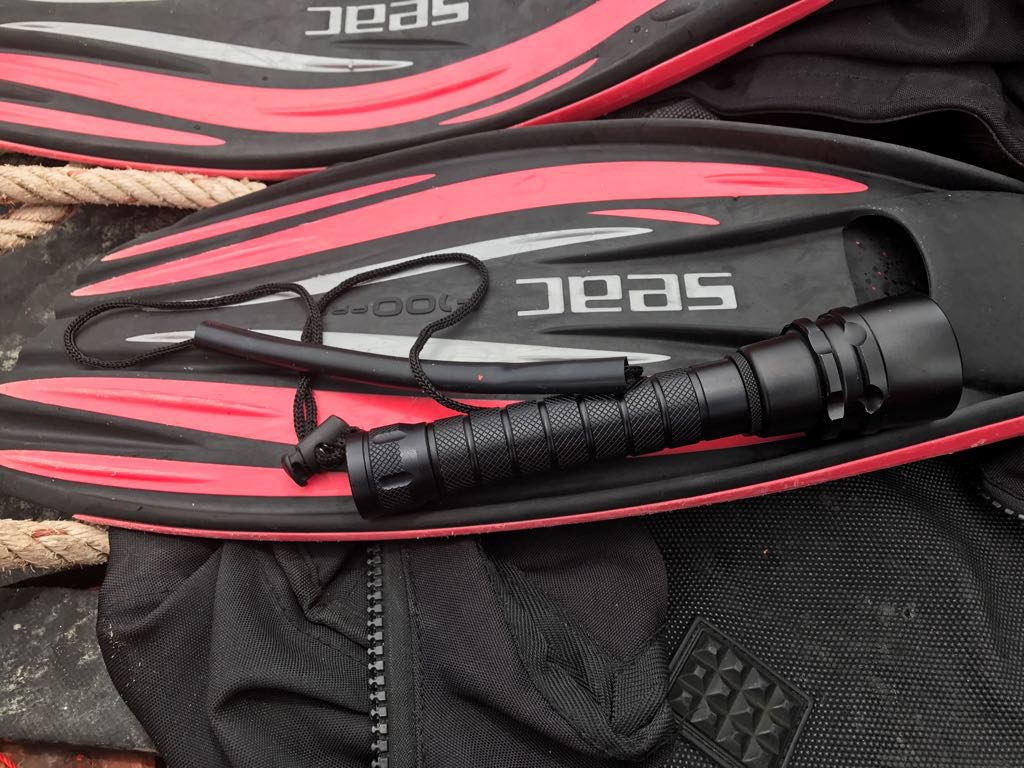
My issues with the light are more with the accessories, nominally the battery and strap.
The strap is little more than a thin rope. The rope feels like it’s a tangle hazard underwater, and indeed, while on a dive this managed to wrap itself around my weight release handles. A bit of careful detangling averted losing my weights. Also, once out, I tested the rope strength – it’s weak enough that you can, if needed, tear it by pulling hard. That’s a good thing underwater! This strap is crucial underwater for this light, as it doesn’t have a handle – and being quite small/light, holding it with 5-7mm gloves becomes a challenge. So for a diving flashlight, a handle would have been much preferred (this is coming from a cold-water diving world. If you dive in 30c+ water, this may not be such an issue).
The second “issue” is the batteries, which, while rated at 3000 mAh, actually hold less than 2000mA after some tests (see table above). That said, regardless of what it says on the tin – they hold a charge long enough to go diving.
So all in all? I would say 4/5 stars if you want it as a diving flashlight; but 5/5 if you want a “land” flashlight. All in all, a good light for the price. Not as bright as some others, but perfectly useable. I would probably even use it regularly were it not for the XHP70 light I prefer from the same company (which I can highly recommend – just hoping to see a 3*XHP70 LED light come out from someone at a sub-€100 price, and am keeping my eyes peeled. Should I find one, I will definitely review it). I will I’ll keep this RQ-3 in my kitbag though, in case my buddy forgets her light it’s a perfectly valid backup even without the handle.
Attachments:
